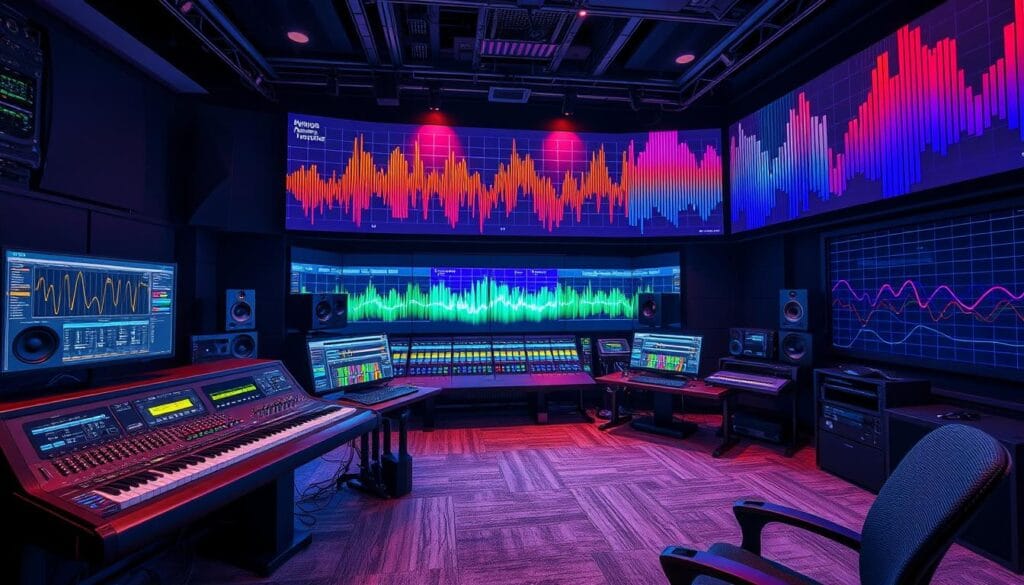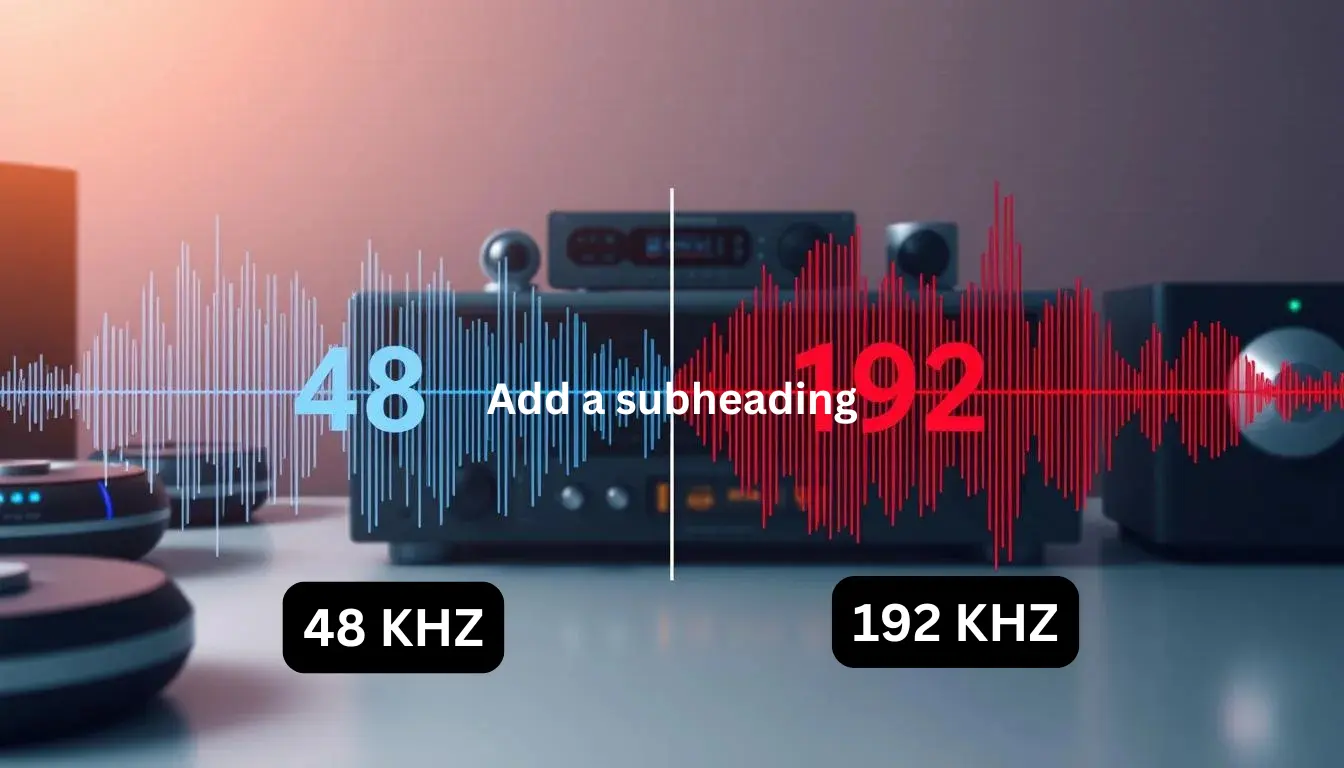Ever wondered why your favorite music sounds crisp on some devices and flat on others? The secret lies in audio sampling rates. These rates are key to digital sound quality, something most listeners overlook. As an audio enthusiast, I’ve delved deep into high-resolution audio and its technical details.
Digital sound is more than just numbers and frequencies. It’s about capturing the soul of music, the subtle vibrations that make each track unique. Audio sampling rates are crucial in this journey, deciding how well sound is reproduced digitally.
Whether you’re a professional audio mastering engineer or a passionate music lover, knowing the difference between 48 kHz and 192 kHz can change your listening experience. This journey will uncover the technical secrets behind digital sound reproduction. It will also help you make better choices about audio quality.
Table of Contents
Understanding Audio Sampling Rates and Digital Sound
Digital audio signal processing turns sound into something computers can get. When you record music or audio, sampling rates are key. They help capture the fine details of sound waves.
Digital sound works by measuring sound often when it’s changed from analog to digital. Think of sampling rates like taking lots of photos of a moving scene. The more photos per second, the clearer the picture.
What Sampling Rate Means in Digital Audio
Sampling rates tell how often sound wave measurements are taken each second. Here are some common rates:
- 44.1 kHz: Standard for cd audio and streaming services
- 48 kHz: Common in professional video and audio production
- 96 kHz: Used in high-end music recording
- 192 kHz: Ultra-high-resolution audio applications
The Science Behind Sample Frequencies
“To capture sound accurately, sample twice the highest frequency in the signal” – Nyquist-Shannon Theorem
Your ears can hear sounds from 20 Hz to 20 kHz. Digital audio systems need to capture these frequencies to play sound right.
Bit Depth and Its Impact on Sound Quality
Bit depth affects how detailed and clear the sound is. Here are some important levels:
- 16-bit: Standard for cd audio
- 24-bit: Professional recording studios’ choice
- 32-bit float: For high-end audio processing
Even though higher sampling rates mean more detailed sound, how much you can hear depends on your gear and where you listen.
Is 48 kHz Better Than 192 kHz Audio
The debate between 48 kHz and 192 kHz sampling rates is intense. Knowing about audio quality can change how you listen to music.
The human ear can hear sounds up to 20 kHz. This makes 48 kHz sampling rates very effective for most music. Interestingly, a 48 kHz rate can accurately reproduce frequencies up to 24 kHz, which is most of what we can hear.
“Not all high sample rates guarantee better sound quality” – Audio Engineering Insight
Now, let’s look at what matters for audio quality:
- 48 kHz is the standard for most smartphones and digital devices
- Opus audio codec defaults to 48 kHz sampling rate
- Higher sample rates like 192 kHz might offer marginal improvements
| Sampling Rate | Audio Quality | Device Compatibility |
|---|---|---|
| 48 kHz | Excellent for most applications | Widespread support |
| 192 kHz | Potential ultra-high resolution | Limited device support |
Premium streaming services like Apple Music and Amazon Music now offer high-resolution audio. They support up to 24-bit/192 kHz. This shows how digital audio formats and high-resolution audio are always getting better.
For most listeners, 48 kHz is the best choice. It offers great sound quality without making files too big. It’s perfect for everyday listening.
High Sample Rate Benefits and Limitations
Looking into audio sampling rates shows a world full of technical details for audio experts. Today’s digital audio workstations offer advanced choices that change how we make music.

Experts in audio mastering say high sample rates have big pluses in making sound. The choice of sampling frequency affects sound quality, how much space it takes up, and how it’s processed.
Practical Applications in Audio Production
High sample rates help in many ways in professional audio production:
- They catch sounds above what humans can hear
- They make it easier to tweak pitches
- They cut down on unwanted sound issues
- They open up more possibilities in sound creation
Storage and Processing Requirements
High sample rates make audio files bigger and need more power to process. Here’s how it affects storage:
| Sample Rate | Bit Depth | Data Rate (kbps) | Storage Impact |
|---|---|---|---|
| 44.1 kHz | 16-bit | 1411 | Standard |
| 96 kHz | 24-bit | 4608 | High |
| 192 kHz | 24-bit | 9216 | Extensive |
Impact on Audio Equipment Performance
Your digital audio workstations face more work with high sample rates. Not all gear can handle 192 kHz audio well. Top systems like the TRINNOV ALTITUDE 32 DSP processor can handle up to 192 kHz, making it great for detailed audio work.
Selecting the right sample rate balances technical capabilities with practical production needs.
Common Audio Formats and Their Sample Rates
Digital music streaming can be tricky to understand, especially with different audio formats. The format you choose affects sound quality and file size.
- FLAC (Free Lossless Audio Codec): An open-source format supporting high-resolution audio files up to 24-bit/192 kHz
- ALAC (Apple Lossless Audio Codec): Apple’s proprietary format with perfect audio reproduction
- WAV and AIFF: Uncompressed formats maintaining original audio quality
- MP3: Compressed format popular for portable music
- AAC: Advanced audio coding format, standard for Apple devices
“The right audio format can transform your listening experience” – Audio Engineering Society
Different digital music streaming platforms offer varying audio quality levels. Here’s a comparative overview:
| Platform | Max Audio Quality | Format |
|---|---|---|
| Amazon Music | 24-bit/192 kHz | Ultra HD |
| Apple Music | 24-bit/192 kHz | ALAC |
| Spotify | 16-bit/44.1 kHz | Ogg Vorbis |
Your choice of audio format depends on your listening habits, storage needs, and devices. High-resolution audio files are great for audiophiles. Compressed formats are better for everyday listening.
Conclusion
Choosing the right sampling rate for audio quality isn’t simple. It depends on many things, not just numbers. Many people find that masters at 44.1kHz sound great, even better than higher rates.
Digital audio best practices show that most devices have limits. Studio monitors, like the ATC SCM110ASL, can only go up to 20kHz-22kHz. This means high sampling rates might not make a big difference for most listeners.
For the best sound, you need a balanced approach. While some players can handle high rates, others might not. Think about your setup and how you listen to music when picking a sampling rate.
The world of audio is always changing. New tech, like Qualcomm’s Snapdragon Sound aptX Lossless, offers exciting possibilities. Your aim should be to find the perfect mix of tech and listening pleasure.
FAQ
What is a sampling rate in digital audio?
A sampling rate is how often a sound wave is measured in digital conversion. It shows how well digital audio matches the original sound. Common rates are 44.1 kHz (CD quality), 48 kHz, 96 kHz, and 192 kHz.
Is 192 kHz really better than 48 kHz audio?
Not always. While 192 kHz has a higher rate, most say 48 kHz is enough for most uses. Our ears can usually hear up to 20 kHz, and 48 kHz can capture sounds up to 24 kHz.
What are the benefits of high sampling rates in audio production?
High rates are good for sound design and making sounds sound different. For example, 96 kHz lets you tweak audio more without bad sound effects.
How do sampling rates affect file size?
Higher rates mean bigger files. A 192 kHz/24-bit file is much larger than CD-quality audio. This can use up more space and slow down audio gear.
What is the Nyquist-Shannon sampling theorem?
This theorem says you need a sampling rate at least twice the highest sound frequency. So, 48 kHz can capture sounds up to 24 kHz.
What are the most common audio formats and their sampling rates?
Common formats include:
– FLAC and ALAC: Lossless, up to 192 kHz/24-bit
– WAV and AIFF: Uncompressed, high-resolution
– MP3 and AAC: Compressed, lossy, for portable use
– DSD: In Super Audio CDs, very high rates
Does a higher bit depth improve audio quality?
Yes, higher bit depths like 24-bit can offer better sound range and less noise. But, you might not always notice it, especially in everyday listening.
When should I use higher sampling rates?
Use higher rates for professional work, sound design, and certain digital tasks. For everyday listening, 48 kHz is usually enough.
